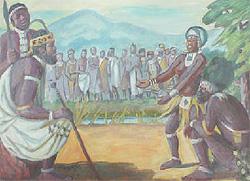
Published date
A period of hardship set in for the AmaXhosa after their defeat in the Eighth Frontier War (also called Eighth War of Dispossession). Their political structures had been fragmented, their beliefs were being tested by a mixture of missionary teachings and European technology and their cattle herds were devastated by lung sickness. In April 1856 Nongqawuse, an adolescent girl living in a part of the country ruled by Paramount Chief Sarhili (Kreli), was reputedly addressed by her ancestors.
Their message was to tell the AmaXhosa that their ancestors would rise from the dead on a certain day and also to instruct them that all cattle were to be slaughtered. There was to be no cultivation, but people should dig new granaries and erect strong cattle-folds to house what would be received from the ancestors.
On that specific day the sun would rise and set again in the east and a whirlwind would sweep all White people into the sea. Sarhili ordered his subordinate chiefs to obey the injunctions. The first date of resurrection was set for 11 August 1856, but as the day dawned and nothing happened, other dates were set, including 18 February 1857. Disappointment followed disappointment, until Sarhili finally renounced all belief in the prophecy after about fifteen months. By then, the AmaXhosa had been nearly decimated. Tens of thousands died, while about 30,000 streamed across the border in search of food and work.
Many AmaXhosa held the belief that the true plotters were land-hungry colonial authorities.
Cameron, T. (ed)(1986). An Illustrated History of South Africa, Johannesburg: Ball, p. 137.|Muller, C.F.J. (ed)(1981). Five Hundred years: a history of South Africa; 3rd rev. ed., Pretoria: Academica, p. 198.